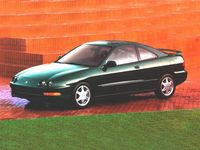New Car Review
1996 ACURA INTEGRA LS
by Tom Hagin
SEE ALSO: Acura Buyer's Guide
SPECIFICATIONS
| Manufacturer's Suggested Retail Price | $ 19,650 |
| Price As Tested | $ 20,085 |
| Engine Type | 1.8 liter I4 w/PFI* |
| Engine Size | 112 cid/1834 cc |
| Horsepower | 142 @ 6300 RPM |
| Torque (lb-ft) | 127 @ 5200 RPM |
| Wheelbase/Width/Length | 101.2"/67.3"/172.4 |
| Transmission | Five-speed manual |
| Curb Weight | 2598 pounds |
| Fuel Capacity | 13.2 gallons |
| Tires (F/R) | 195/60R14 |
| Brakes (F/R) | Disc-ABS/disc-ABS |
| Drive Train | Front-engine/front-wheel-drive |
| Vehicle Type | Five-passenger/four-door |
| Domestic Content | 5 percent |
| Coefficient of Drag (Cd.) | 0.33 |
PERFORMANCE
| EPA Economy, miles per gallon city/highway/average | 25/31/29 |
| 0-60 MPH | 7.8 seconds |
| 1/4 mile (E.T.) | 16.3 seconds @ 86 mph |
| Top Speed (Est.) | 125 mph |
| * Port fuel injection |
Acura is starting into its second decade of building automobiles, and in July, 1994, the company sold its one-millionth vehicle. It has weathered the storm of the rising and falling yen and at just under $20,000, the Acura Integra slots into the median of the average price of a new car today. That price is rising, but if Integra continues a strong showing, it (or its descendants) will be around for many more decades.
OUTSIDE - Acura gave the Integra a new look in 1994, with a slippery shape to efficiently slice the wind, and projector beam headlamps for a cleaner, more modern look. Thin roof pillars and a low cowl give an excellent view from the driver's seat, but the reduced metal doesn't make the car weak. In fact, the new Integra sedan is 50 percent stiffer than the model it replaced, which is noticeable on the road. Of special note is a small pin inside the window tracks which keeps the side glass from becoming affected by negative pressures (it causes a whistling sound) caused by high vehicle speeds. Standard exterior features on Integra LS include body-color bumpers, outside mirrors and bodyside molding, full wheelcovers and Michelin all-season tires.
INSIDE - Though classified as a subcompact by the EPA, Integra is much larger inside than expected. Up front is ample head and legroom, with plenty of seat adjustments, including lumbar support, for a comfortable trip. And while the rear seats aren't made for huge people, they will accommodate two moderately sized adults; three in a pinch. Full analog instrumentation seems in the right places, and feature white-on-black lettering, making them easy to read. Integra LS models come standard with air conditioning, AM/FM cassette stereo, full center console, tilt steering, cruise control, power windows, mirrors, door locks and antenna, as well as a power moonroof. Acura has paid special attention to occupant safety, with side-impact beams in each door, and padding at both the hip and shoulder level to reduce the energy transmitted to those inside in event of an accident.
ON THE ROAD - All but the Integra GS-R model come with a peppy 1.8 liter four cylinder engine which produces 142 horsepower and 127 lb-ft of torque. There are several cars in its class costing less that have a slight horsepower advantage, but few can match the smooth power delivery or dependability of the Acura's powerplant. It's a free-revving engine that seems perfectly suited to both high-speed cruising and around-town driving. Our test car came equipped with the standard five-speed manual transmission, and we liked it that way. It provides fault-free gear changes via smooth-as-silk shift linkage. A flip of the wrist and the next gear slides effortlessly into place. For those who resist rowing through the gears, however, there is an optional four-speed automatic transmission that utilizes "grade logic" which features electronic controls to eliminate unwanted gear-hunting during uphill or downhill driving.
BEHIND THE WHEEL - It seems that every car maker is developing improved steering systems. Acura is one of those, and Integra models use a new torque-sensing system that is lighter and more compact than previous units. Where many upscale cars modulate steering effort based on road speed (the steering gets stiffer at high speeds), Acura's steering varies in accordance with a combination of engine speed (rpms), and the amount of torque generated between the wheel and tire. This gives more control over power-steering boost, and offers more precise action. The front and rear suspensions of the Integra are both fully independent, with relatively stiff springs and shocks to give nimble handling, yet still provide a soft ride on our LS model. Braking is excellent as well, with four wheel disc brakes assisted by an anti-lock braking system (ABS). We were able to stop the vehicle in 120 feet on dry pavement, with virtually no brake fade after repeated stops. Wet pavement extended those distances to around 175 feet, but halted the vehicle in a straight line.
SAFETY - Dual airbags, ABS, side-impact beams and adjustable shoulder anchors on the front belts round out its safety features.



